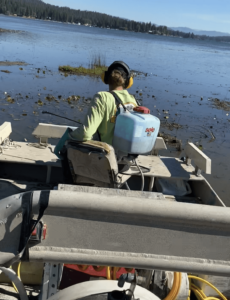Aquatic Herbicide Control Methods
Aquatic plant management: herbicide control methods
Aquatic plants are an important part of a healthy lake. They provide habitat and food sources for fish and wildlife, help stabilize bottom sediments and help prevent shoreline erosion. Some aquatic plants are considered invasive and may cause problems. Native vegetation may also become a nuisance. If a lake management service provider suggests that treatment of aquatic plants is warranted (see “Management Plans” fact sheet), lake stakeholders have several options for control strategies. These include herbicides, physical/mechanical control and biological methods (the latter two have separate fact sheets).
 What are herbicides?
What are herbicides?
Herbicides are chemicals that have been designed to damage and/or kill plants. Examples of herbicides with formulations to be used in lakes are 2,4-D, triclopyr, diquat and fluridone (these are known by different trade names). The use of a newly developed herbicide, florpyrauxifen-benzyl (trade name, ProcellaCOR™) is increasing, as initial results indicate it is more effective on invasive plants and has fewer negative impacts on native plants.
Herbicides vary in several ways. One of the most significant is whether they work through contact (herbicide injures the plant tissue it touches) or systemic (herbicide is absorbed through leaves, stems or roots and moved through the plant). To the observer, contact herbicides appear more effective because plant damage occurs quickly (hours to days) while systemic herbicides take longer (days to weeks). Which herbicide is most appropriate, however, depends on many factors such as human water use, native species present, the specific invasive species and lake conditions (e.g., water movement, depth). A lake management service provider (see “Management plans” fact sheet) can help inform this decision.
Benefits and drawbacks of herbicides
Herbicides for aquatic plant control may offer ecological and economic benefits if applied judiciously, after development of a lake management plan. Reducing invasive plants can restore recreational opportunities and improve habitat for native plants and animals. Herbicides are relatively easy to apply (as compared with some mechanical/physical methods) and often result in a fast reduction of invasive plants. They have several limitations and drawbacks, however, that aren’t immediately apparent.
First, they can have limited effectiveness. This can result from using the wrong herbicide for the situation (either it is not effective for that plant or the lake conditions). In addition, many herbicides only weaken plants for several weeks. Many invasive plants regrow either within the same season, or next season, leading to repeated herbicide treatment with little long-term improvement. This is especially true for partial lake treatments (whole-lake herbicide applications may last longer).
Second, most herbicides have at least some negative impacts on native plants, invertebrates, fish, reptiles, amphibians and/or birds (these are called “non-target impacts”). In a Wisconsin study, exposure to 2,4-D at conventionally applied concentrations impacted survival and/or development of young northern pike, largemouth bass, walleye and yellow perch, white sucker, and fathead minnows. A second Wisconsin study compared the ecological effects of Eurasian watermilfoil with the effects of lake-wide herbicide treatments (2,4-D) used for Eurasian watermilfoil control; they found that lake-wide herbicide treatments aimed at controlling Eurasian watermilfoil had larger negative effects on beneficial native aquatic plants than did Eurasian watermilfoil itself. While this study only looked at a subset of the herbicide/plant combinations, it is a cautionary result that underscores the importance of comparing impacts of plant management with the impacts of the plant itself, particularly as many herbicide applications only result in short-term control (e.g., 2,4-D on Eurasian milfoil). The short- and long-term non-target impacts of herbicides on wildlife should be carefully considered.
How to conduct an herbicide treatment?
In many states herbicide can not be applied to a water body without a permit from the state natural resource agency. Given the numerous considerations when selecting and applying an herbicide (which/when/where/how to apply the herbicide), people should work with a lake management service provider and their state natural resource agency to develop a treatment plan. The service provider will help plan the optimal approach for your lake (see “Management Plans” fact sheet). The state’s natural resource agency is also a good resource for technical advice on the management of nuisance and invasive aquatic plants. Due to equipment, scale and safety considerations it is most common to hire a professional treatment applicator following development of an aquatic plant management plan. Selection of a treatment applicator is relatively straightforward. The lake management service provider will recommend which treatments to use, and an internet search for that method and your location within the state should yield results. From there, a comparison of estimates and referrals will help narrow down the choice. For the applicator, a degree is not needed, but a familiarity with aquatic plants and a license from the USDA and state permitting agency (e.g., Wisconsin DNR) are needed for application. Herbicide treatment requires permitting at the state level and notice to lake property owners near the treatment area.
The cost of herbicide application will vary based on which herbicide is used, the area treated and the number of treatments.